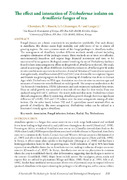| dc.description.abstract | Fungal diseases are a biotic constraint in tea production worldwide. One such disease
is Armillaria. The disease causes high mortality and yield losses of tea in almost all
growing regions. The most common strain of this fungal pathogen is Armillaria mellea.
The management of Armillaria involves different methods mostly cultural including
complete elimination of the pathogen source. These methods are at times non-effective,
environmentally-hazardous and require huge financial investment and time to be
encountered by tea growers. Biological control involving the use of Trichoderma has been found to have some antagonistic effect on the growth of Armillaria on the soil. This study aimed at assessing the effect of different Trichoderma isolates on Armillaria growth under in vitro conditions to ascertain its utilization. A total of 14 isolates (T-series) were screened during the study. Armillaria isolates (9T2 and 5H1) were obtained in two regions; Tigania
and Hamisi tea growing regions in Kenya. Culturing of Armillaria was done on Extract
Agar while Trichoderma on PDA agar. Association was done in vitro on nutrient agar and
measures of interaction recorded based on radial growth. The setup was undertaken at the Tea Research Foundation, IPDM Laboratory and each treatment replicated three times. Data on radial growth was recorded at intervals of two days for four weeks. Data was analysed using MSTAT-C software. The results indicated that most Trichoderma isolates
showed antagonistic effect by restricting Armillaria growth though there was significant
difference (P = 0.05). T45 and T19 isolates were the most antagonistic among all other
isolates. On the other hand, Isolates T13 and T. asperrellum caused minimal effect on
growth of Armillaria. The most antagonistic Trichoderma isolate can be utilized as a
biocontrol remedy against Armillaria. | en_US |
